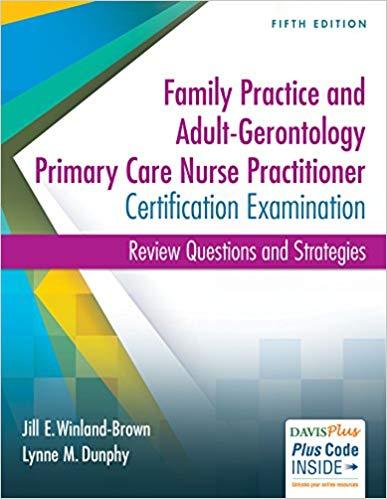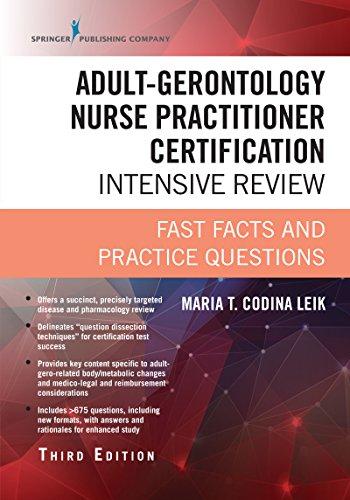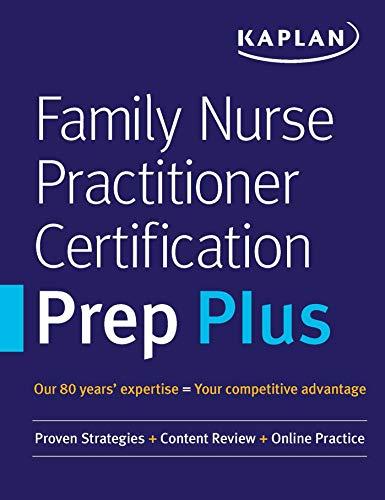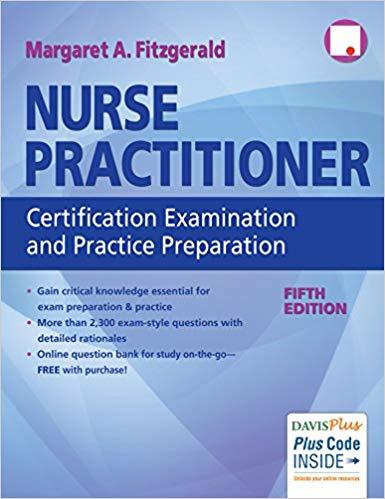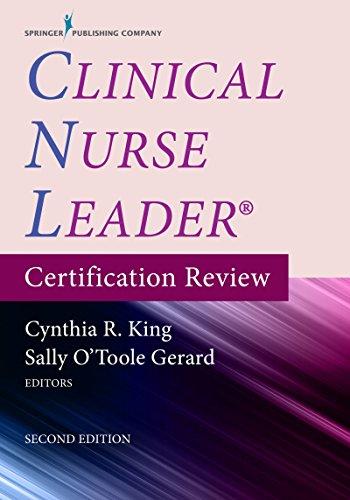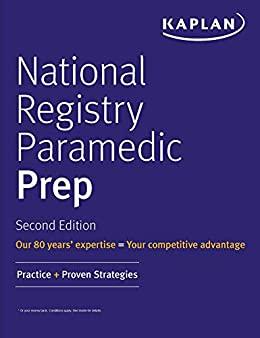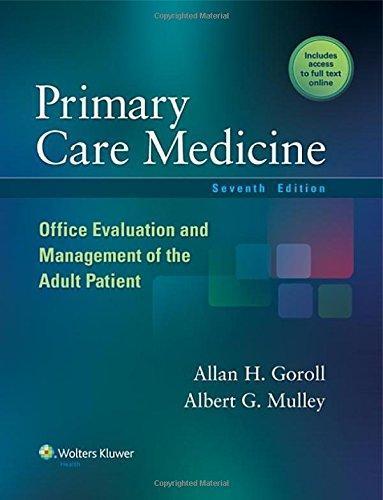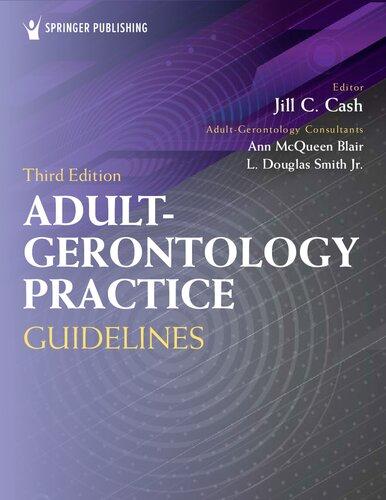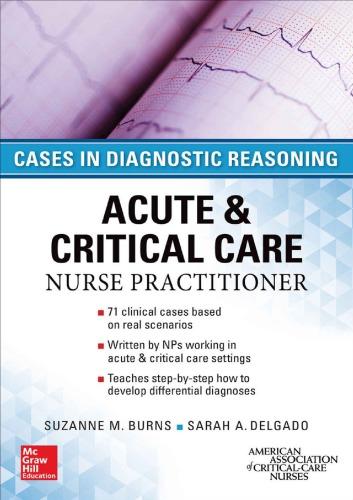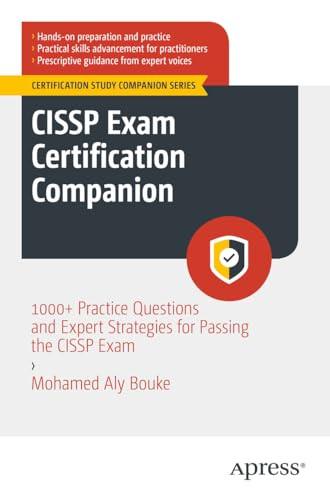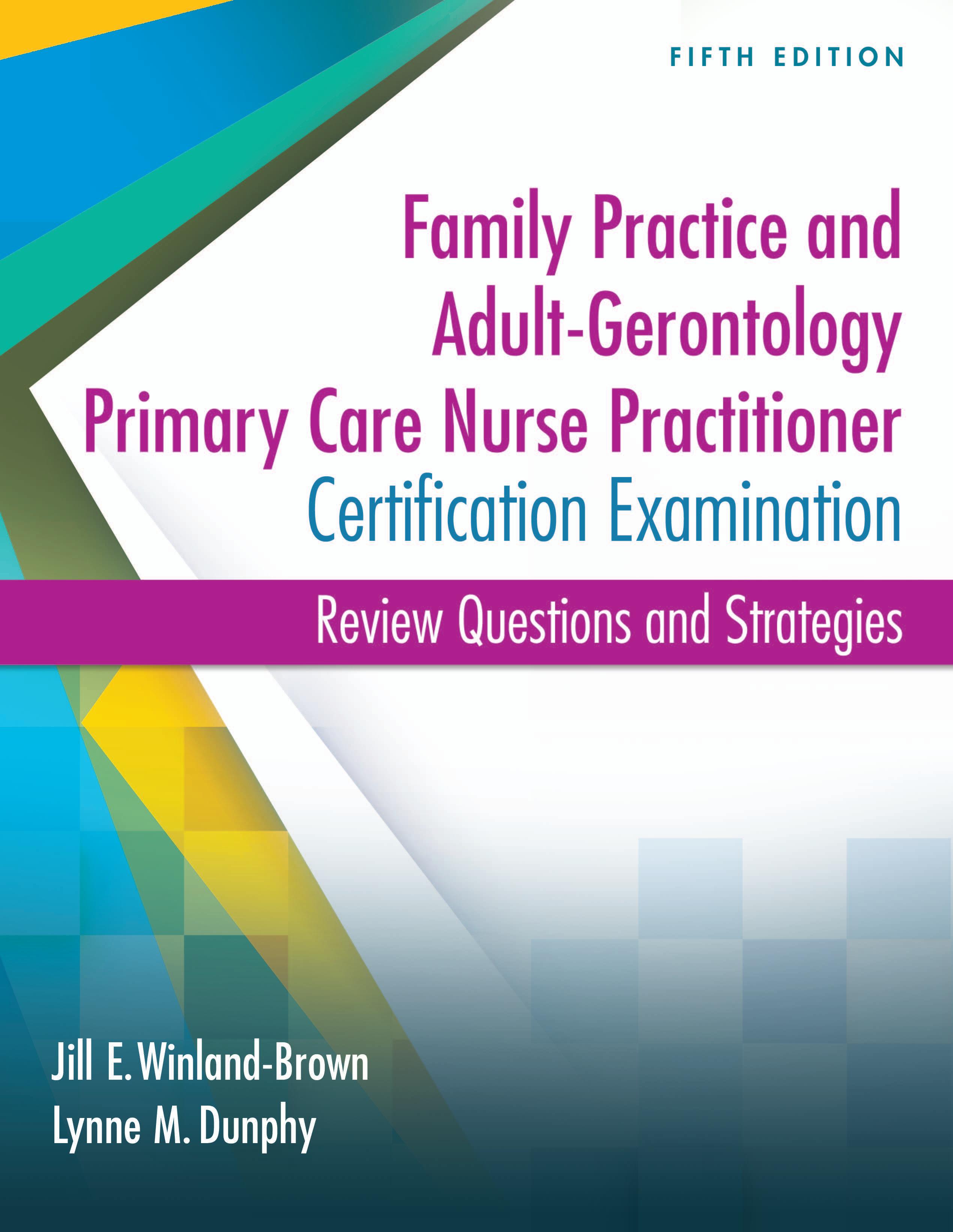Chapter 1: Achieving Success on a Certification Examination
Certification and Why It Is Important
Licensure
Certification
Your Role
Certification Examinations
American Nurses Credentialing Center
American Academy of Nurse Practitioners Certification Program
Achieving Success
References
Lynne M. Dunphy and Gary Laustsen
With the purchase of this book, you have taken a major step to achieving or maintaining your certification as an advanced practice registered nurse (APRN). The earlier in your educational process you begin preparing for the certification examination, the greater your chance of success. This book will help you understand the certification process and the steps you need to take to succeed on the certification examination of your choice.
Certification and Why It Is Important
There are basic differences between becoming licensed (a process you complete with your state’s board of nursing or similar entity) and becoming certified. An understanding of these differences is important.
LICENSURE
Licensure is a legal requirement of each state to practice nursing in that state. The purpose of licensure is to protect the public from unsafe practitioners. Legal regulation of nursing practice (whether at the RN or APRN level) is the joint responsibility of the state legislature and the state board of nursing (and in some states the board of medicine). Registered nurse (RN) licensure is a requirement for enrolling in APRN
programs, and most states require individuals to maintain their RN license to apply for and maintain their APRN license. All but a few states currently require certification to apply for an APRN license. In addition to the states’ requirements of certification for licensure, clinical facilities, employers, and insurance payers require certification.
CERTIFICATION
Certifi cation is the process by which a nongovernmental agency or association grants recognition to an individual who has met certain predetermined standards for practice. For APRN certification, this is achieved through the successful passing of a certifi cation examination. Becoming certifi ed is the standard for APRN professionals. As of this writing, only New York, California, Indiana, and Kansas do not require certifi cation prior to obtaining licensure to practice as a family nurse practitioner (FNP) or adult-gerontology primary care nurse practitioner (AGPCNP).
Certification exams, based on an analysis of current practice, validate entry-level knowledge in an advanced nursing specialty in a defined population area. Certification exams are competency-based examinations that provide a valid and reliable assessment of entry-level clinical knowledge and skills of a
APRN Specialties
Focus of practice beyond role and population focus linked to health-care needs
Examples include but are not limited to Oncology, Older Adults, Orthopedics, Nephrology, Palliative Care
Population Foci
nurse practitioner. This certification aligns with the Consensus Model for APRN Regulation: Licensure, Accreditation, Certification, and Education (LACE). Certification exams are administered through testing divisions of professional associations. These include the American Nurses Association (ANA) subsidiary, the American Nurses Credentialing Center (ANCC), and the American Association of Nurse Practitioner’s American Academy of Nurse Practitioners Certification Program (AANPCP). National certification examinations by these bodies designate an APRN role in a specific population (see Fig. 1-1), serve as eligibility for licensure to practice in most states, and are required for most third-party reimbursement, as well as institutional credentialing. For a list of some of the main purposes of national certification, review Box 1-1.
In summary, the candidate for certification as an APRN should recognize that certification is a formal process conducted by nongovernmental organizations to validate entry-level APRN knowledge, skills, and competencies, based on predetermined standards and practice analysis, and is a part of the requirement in most states to obtain licensure and status as an APRN. See Box 1-2 for recognized certifying organizations for FNP or AGPCNP practice.
YOUR ROLE
You are making an important decision to become an APRN or to maintain your certification through
Box 1-1: Purposes of National Certification
• Required for advanced nursing practice licensure in all but a few states
• Indicates specific advanced role and populationbased competencies at an entry level building on foundational nursing knowledge
• Required for third-party reimbursement in Medicare populations as well as by most other insurers
• Often required for institutional credentialing
• Required by the U.S. Department of Veterans Affairs and the U.S. Armed Forces
• Required to obtain a National Provider Identifier (NPI)
Box 1-2: Recognized Nursing Associations and Organizations Offering Advanced-Practice Nursing Certification for the Nurse Practitioner Role
American Academy of Nurse Practitioners Certification Program (AANPCP): http://www.aanpcert.org
American Nurses Credentialing Center (ANCC): http://www.nursecredentialing.org
retesting. The purpose of this book is to help you achieve that goal, but your role in this process requires a commitment in time and effort to be successful.
Table 1-1 lists the requirements for nurse practitioner certification by the ANCC and AANP as of
APRN roles
APRN REGULATORY MODEL
Figure 1-1
TABLE 1-1
. REQUIREMENTS TO SIT FOR NURSE PRACTITIONER CERTIFICATION
ANCC AANP
• Present final, degree-conferred transcripts
• Present validation of Education Form signed by program director/ faculty
• Be a graduate (or imminent graduate) of an accredited Master’s NP, post-graduate NP, or DNP program
• Present official final transcript with date degree conferred
• Complete program faculty–supervised clinical clock hours
• Hold a current RN license
2015. You must keep abreast of both of these credentialing Web sites for continued and changing information regarding the details and processes for taking the certification exam. To qualify to take an examination and become certified at the APRN level, a nurse must (1) meet the requirements for clinical or functional practice in a specialized field and (2) provide evidence of successful completion of an approved Master or Doctor of Nursing Practice curriculum.
Certification Examinations
This book is geared toward the person who is seeking national certification as an AGPCNP and/or FNP. The AGPCNP certification examination is designed to assess your abilities as an APRN in the delivery of primary care services to an adult population, defined as adolescence through old age. The gerontological nurse practitioner (GNP) certification is no longer offered by either ANCC or AANPCP.
The FNP certification examination is designed to assess your abilities as an APRN in the delivery of primary care services across the life span, including preand postpartum care, pediatric primary care, and the care of older adults. This spectrum of care is sometimes referred to as “cradle to grave.”
AMERICAN NURSES CREDENTIALING CENTER
The ANCC Web site contains the certification handbook, including a test content outline (TCO) that
TABLE 1-2. ANCC FAMILY NURSE PRACTITIONER CERTIFICATION
CONTENT OUTLINE (2016)
DOMAINS OF PRACTICE
OF QUESTIONS PERCENT OF QUESTIONS
describes the major categories and domains of practice, as well as related topics and subtopics, which are covered on the examination. The examination currently consists of 200 questions, 175 of which are scored and 25 pilot questions that are not scored. The nonscored questions cannot be distinguished from the scored items.
The TCO includes information about how the content is weighted—that is, how many or what percentage of the test questions are in each of the major domains. Table 1-2 lists the major categories or domains of practice for the FNP examination and includes an approximate number of questions and the overall percentage for each category. To facilitate understanding of each of the major domains, the ANCC also includes subcategories in a topical outline format. Table 1-3 provides similar information for the AGPCNP examination.
The importance of reviewing the current handbook and TCO before sitting for the examination cannot be
TABLE 1-3. ANCC ADULTGERONTOLOGICAL PRIMARY CARE NURSE PRACTITIONER CERTIFICATION
(2016) DOMAINS OF PRACTICE
overstated. All questions are classified according to life span and problem-focused content areas. The life span dimension for the AGPCNP examination includes non–age-specific content as well as specific content pertaining to the adolescent, the adult, and the aging adult. The FNP life span dimension includes the same content as the AGPCNP examination plus content relating to children, infants, and childbearing women. The gerontological population is defined as persons older than age 65.
The last dimension is related to problem areas and organizes question content by body system—for example, cardiovascular, endocrine, and respiratory.
What this means is that each test question in the Foundations for Advanced Practice and the Independent Practice domains is characterized across three dimensions. For example, a test question that asks about the treatment of a 70-year-old woman with a diagnosis of osteoporosis would be characterized as follows:
• Dimension 1—Clinical Management
• Dimension 2—Life Span: Older Adult
• Dimension 3—Problem Area: Musculoskeletal
Be aware that the TCO may change from examination to examination, so you need to review your handbook carefully for the most current content breakdown.
To assess each examinee’s level of specialty knowledge independent of the group taking the examination, a criterion-referenced standard is used. In this approach, each examinee’s score is compared with an absolute number determined by the content experts who develop the examination. You need to answer every question. Even if you have no idea of the answer, by sheer chance alone you stand a 25% chance of guessing the correct answer. You are not penalized for incorrect answers.
The test-development committee determines the passing score after careful consideration of the content of the test questions. The passing score is always expressed in terms of the number of questions you must correctly answer on the total test. Diagnostic feedback is given if the examinee fails the certifi cation exam. Additional statistical examination of the pilot questions is assessed for inclusion in the fi nal graded pool of test questions on the next examination.
Your performance on the total test determines your success or failure. The examination is administered year round in a computerized testing center. You are permitted 3.5 hours to answer 200 questions. Plan
an additional 30 minutes for check-in and practice time at the computer, including a tutorial. Because it is a computerized examination, you will receive your score 3 to 5 minutes after completing the examination. A passing score is 350 or higher of a possible 500 points; 2014 statistics reveal 80.5% of AGPCNP and 73.8% of FNP candidates passed on their first attempt. If not successful, a candidate can apply to retest after 90 days.
You will need to be recertified every 5 years. At present, 500 hours of active practice must be attested over the previous 5 years. Additionally, continuing education credits and/or academic credit must be documented. If not able to clinically practice, or if there is a lack of continuing education and/or academic credit, a practitioner may elect to retake the certification examination as a way of demonstrating current competency. Please check the ANCC Web site for the most current information because guidelines for recertification are subject to change.
AMERICAN ACADEMY OF NURSE PRACTITIONERS CERTIFICATION PROGRAM
The AANPCP currently offers competency-based national certification examinations for the AGPCNP and FNP. Reflecting APRN knowledge and expertise, the content areas of these examinations include health promotion, disease prevention, and diagnosis and management of acute and chronic diseases. The examinations given by the AANPCP were developed in conjunction with the Professional Examination Service, a not-for-profit organization with more than 50 years of experience in developing and administering national licensing and certification examinations in health-related fields.
In order to take either certifying examination, candidates must possess a master’s or doctoral degree (DNP) from an accredited program. This certification program is fully accredited by the National Commission for Certifying Agencies (NCCA).
The AANPCP, in conjunction with the Professional Examination Service, conducted a roledelineation study to determine areas of clinical knowledge to be tested. As a result of this study, the examination was structured around assessment (approximately 48 questions, or 36%), diagnosis (approximately 33 questions, or 24%), formulation/ planning/implementation of treatment plans (approximately 31 questions, or 23%), evaluation and follow-up (approximately 24 questions, or 17%). The Web site and handbook also provide a list of knowledge areas
for the FNP and AGPCNP exams. Examinees must be able to integrate knowledge of pathophysiology, psychology, and sociology with the assessment, diagnosis, and treatment of patients in primary care. Knowledge of health promotion and disease prevention, as well as management of acute/episodic and chronic illness in the primary care setting, are tested.
The AGPCNP examination tests knowledge of adolescent, adult, and geriatric primary care; the FNP examination tests clinical knowledge of prenatal, pediatric, adolescent, adult, and geriatric primary care. These examinations use growth and development as the basis of age-related changes, and specific age parameters are not defined for any population.
These AANPCP examinations have a pass rate of 87.5% for FNP and 85.7% for AGPCNP according to 2014 data. They are also computer-based examinations offered year round. You know whether you have passed or failed at the end of the examination.
Achieving Success
Nurse practitioner programs often focus on assessment, management, and evaluation of disease. Indeed, this is the role most of you perform in your respective work settings. The ability to diagnose and treat disease is paramount to your safe and effective functioning as an APRN, and certification examinations increasingly reflect this reality. However, it is important never to lose sight of the fact that these examinations are certifying your abilities as an APRN and as such have an underlying commitment rooted in nursing-based knowledge, health, health promotion, and human responses to health and illness. This is especially apparent on the TCO of the ANCC examination. Fully 37% of content is labeled “Foundations of Advanced Practice.”
As an APRN, your reaction to the various manifestations of health and illness phenomena is instinctively different from that of other primary care providers. This comes up in different ways on each examination, but it is an important distinction to keep in mind as you ponder the various question responses and wonder what answer is the best. Similarly, the test blueprints and types of questions asked refl ect a continued commitment to concepts of health promotion and disease prevention as well as to the underlying principles of therapeutic communication skills that are so essential to forging meaningful APRN-client relationships. Nursing-based elements of growth and development, nutrition, and therapeutic communication, as well as questions
about cultural differences and cross-cultural communication, will be integrated with content concerning specific aspects of diagnosis, pharmacology, and disease management.
Questions testing physical assessment and history-taking skills, as well as content from advanced physical assessment, remain prominent. Although a certain amount of basic pharmacological content is included, the latest drugs and pharmacological interventions may not always appear because the examination questions are prepared and tested well in advance. (Note: Questions about your knowledge of safe prescribing for pregnant women almost always appear on the FNP examinations.)
Be careful in applying your experiences from clinical activities as a student or as a newly certifying APRN. The correct answer and other answer choices—also referred to as “distractors”—will not necessarily correlate with what you’ve currently seen. Remember, the examination reflects the ideal answer according to the references used and the expert panels of the certifying body; this ideal answer may not always mirror the realities of specific practices. Test answers are drawn from national guidelines and standards of practice promulgated by a variety of bodies. New national guidelines or standards may take up to a year for questions to be developed, piloted, and then included in the exam. The questions on the examination are looking for generalized responses and might well reflect phenomena that you have not seen. Allowing yourself to become frustrated with the distractors will not help you but rather will hinder your ability to succeed. This is why it is essential that you study large numbers of sample test items (see chapter 2).
Being test savvy and succeeding on a multiple-choice examination is a far different skill from the expert skills you bring to your practice. These skills are not mutually exclusive. It is a matter of having the correct mind-set—one predicated on an awareness of the nursing base of the certification examination coupled with an understanding of the test blueprint. Be determined not to select an anecdotal answer based on experience from your practice experiences but rather to select an answer based on nationally recognized, clinically based guidelines and rooted in clinical literature.
You have taken the first step toward certification by purchasing this book. Understand the essential reasons to become nationally certified. Fix the end goal vividly in your mind. Imagine how you will feel when you receive that message on the screen saying PASS, knowing that you are a nationally certified APRN.
Take the next step on the road to success by turning to chapter 2. It will assist you in the development of important test-taking skills and provide guidelines for creating your individualized study plan.
References
Advanced Practice Registered Nurse Consensus Model for Regulation: http://www.nonpf.org/default .asp?page=26
American Academy of Nurse Practitioners Certification Program description: http://www.aanp.org/ education/aanp-certification-program
American Nurses Credentialing Center certification Web page: http://www.nursecredentialing.org.
Dunphy, LM, Winland-Brown, JE, Porter, BO, and Thomas, D: Primary Care: The Art and Science of Advanced Practice Nursing, ed 4. FA Davis, Philadelphia, 2015.
National Organization of Nurse Practitioner Faculties: http://www.nonpf.com/
Chapter 2: Test-Taking Skills and Designing Your Study Plan for APRN Certification
Study Habits: Know Yourself
What Is Your Preferred Learning Style?
Active Versus Passive Studying
Getting Started
Tips for Studying
Nature of the Exams
Test-Taking Skills: An Acquired Art
General Strategies
Basic Tools
Specific Strategies
Designing Your Study Plan
Assess and Diagnose Plan and Implement Evaluate
Last-Minute Preparations: Relaxed and Ready
References
This chapter has several parts. The fi rst part actively assists you in assessing your study and testing style. It prepares you to develop an individualized study plan that will enable you to achieve your goal: becoming a nationally certifi ed advanced- practice registered nurse (APRN). Another part reviews the nature of the adultgerontology primary care nurse practitioner and family nurse practitioner certifi cation examinations (we use the term “exam” from this point on) and how that translates to actual test questions. The remaining parts deal with the specifi cs of answering multiple- choice test questions and the skills necessary to succeed on a multiple- choice exam. Evaluating test- taking skills, developing a formal study plan, and being ready on exam day are also covered.
Study Habits: Know Yourself
There are several approaches to developing good study habits and effective test-taking skills. Among them are recognizing what your preferred learning style is, realizing the importance of active versus passive studying, and following basic tips for getting started and developing test-taking skills.
WHAT IS YOUR PREFERRED LEARNING STYLE?
Awareness of your learning style will guide you in selecting study strategies. Learning styles are related
Lynne M. Dunphy and Gary Laustsen
to the pathways or channels through which you prefer to absorb information. The three types of learners are commonly identified as visual, auditory, and tactile (sometimes called kinesthetic).
Visual Learners
Visual learners learn better from reading and writing than from hearing and talking about information. They usually find background noise, such as music and television, distracting rather than helpful. Following are strategies for visual learners:
• Read texts in a quiet place.
• Watch appropriate videos.
• Use visual study aids such as concept maps, flash cards, and charts.
• Use highlighting markers or colored paper to take notes.
Auditory Learners
Auditory learners grasp information most effectively by listening and talking. Combining information with music often works well for auditory learners. Following are strategies for auditory learners:
• Read texts aloud.
• Listen to audiotapes of course material.
• Make up a song about the content and sing it aloud (especially helpful for assimilating difficult content).
• Listen to background music or other noise.
• Talk about the content with a study partner.
Tactile or Kinesthetic Learners
Tactile or kinesthetic learners prefer to learn “hands on.” They have difficulty sitting still for long periods. During study sessions, they should stand and move around or take frequent stretch breaks. Integrating physical activity with study works well for these learners. Following are strategies for tactile learners:
• Move around while studying.
• Read while exercising on a stationary bicycle.
• Listen to tapes of learning material while walking or biking.
• Rewrite or type notes.
Although almost everyone is capable of learning through all their sensory pathways, most have a preferred
channel. Think about which of the three learning styles discussed works best for you. Time is often at a premium for nurses studying for certification, and capitalizing on your preferred learning style will help you study in the most efficient way. Keep strategies for your preferred learning style in mind as you develop your study plan.
ACTIVE VERSUS PASSIVE STUDYING
Regardless of your personal learning style, the more actively you are engaged in the material, the better your ability to retain and comprehend content. For example, many of us have had the experience of reading an entire chapter, or listening to a review CD, only to find that our mind drifted away sometime earlier and we have difficulty recalling even the most basic information. Time is a precious commodity, so it is far more efficient to learn actively the first time than to reread or relisten to an entire chapter a second time. Tips used to improve active learning include taking notes while reading and pausing after each heading or subheading to summarize the content. Can you identify the main idea that the author was attempting to impart? Did you pass over new terms without taking the time to become familiar with them? As you read a summary, do you realize that you really need to go back to a more detailed reference because your knowledge is insufficient? Although active engagement may slow you down initially, it will save you time in the long run because now you are involved in active learning and not simply hoping that something will stick as you speed by.
GETTING STARTED
Studying, like regular exercise, is good for the brain. As a health-care professional, you will find that it will always be your job to keep abreast of the professional literature and spend some time studying. To recertify, you are mandated to keep your practice current through a combination of clinical hours and continuing education options. The earlier you begin to plan for certification or recertification, the better. The principles of effective study are simple— worthwhile studying takes time and effort. And in today’s world, time is a precious commodity. Therefore, if you want to study, you need to set aside adequate time and plan accordingly. Be prepared to delay the start of new projects until this one is complete and you have successfully taken the exam. There is no way around the hours involved. There are no shortcuts. But you need to make it easy to begin.
TIPS FOR STUDYING
Just as a cold engine will run a little rough, settling down to study when one is out of the habit can be difficult. The following suggestions should make it easier to begin studying and to return to it on a regular and consistent basis.
• Create a pleasant personal environment. This is a very basic but frequently overlooked requirement for successful study. Organize all your study materials in one area. Try to create a pleasant and regular work space for yourself. Perhaps it will be just part of a room, but make it an inviting part. Decorate it with flowers, pictures, or whatever makes the area appealing to you. For the kinesthetic learner, an open area that allows free movement may be better than a small office. Some literature suggests that playing classical music, especially from the baroque era, in the background increases concentration and retention. Decide whether background music is helpful for you or distracting. Background music may be helpful for an auditory learner, whereas a visual learner may find it a distraction.
• Plan your activities in advance and be realistic. Plan in advance what you are going to work on and do not be overly ambitious. Blocks of 1 hour at most are recommended, with a 10-minute break every 45 minutes. List the tasks beforehand; otherwise, you might spend valuable time trying to decide what material to review. Set specific targets for the time available.
• Keep focused on the goal: becoming certified! Keep the benefits of studying clearly in mind—in this case, the joy of receiving your passing score, followed by your embossed certificate in the mail. Visualize and imagine what it will feel like when you read the word PASS on the computer. Picture the certificate framed and hanging in your office. Focus on these results and how they make you feel. Close your eyes and allow the feelings to flood through you!
• Use your knowledge of yourself and of basic tips. There are a number of ways you can make studying more fun. Make use of your best time of day. For some, this might mean rising early while the rest of the household sleeps and stealing time alone, undisturbed, with a hot cup of tea or coffee. For others, evening is
preferable. Study for short periods with frequent breaks.
• Integrate whatever learning modalities work best for you. For example, if you are an auditory learner, use recordings. Listening to recordings while you are walking is especially good for tactile learners.
• Think in terms of “bite-size” pieces and structure your study plan accordingly. Use the “salami” principle: Cut large tasks into smaller ones and digest them one at a time. This will keep you from becoming overwhelmed and defeated before you begin.
• Variety is essential. For example, divide your time between test question review and content review, or break up the study period into a variety of different tasks. Take notes for part of the time and read for part of the time. Do not keep at any one activity—even your practice exams—for longer than 45 minutes. Try studying with a study group part of the time. Discussing the materials with others is an especially good strategy for auditory learners. Although a 45-minute session is ideal for most of your study time and for taking practice exams, it is helpful to experience at least one practice exam with many questions (~150) to get a sense of what it will be like when you take the actual certification exam.
• Study with your purpose in mind—in this case, passing the certification exam. Research has shown that two-thirds of your study time will be most effectively spent taking sample test questions. Do not lose sight of this! Studying does not necessarily mean sitting and reading textbooks. Reading books in a linear fashion is often not the most effective way to master information. Always keep the end result in mind.
• Leave the environment in readiness for your next session. Leave your work environment inviting for the next time. Put your materials away so that they are easily accessible. Do not leave the area cluttered; instead, make it more pleasing. Spend the last few minutes of your study time tidying up so that your environment is all set for your next session. This is also an excellent time to plan what you will do the next time you sit down to study. Believe it or not, these small, concrete habits can make a big dent in your natural tendency to procrastinate.
• Reward yourself. Last but not least, reward yourself! Reward yourself for each study period. You might decide that if you spend 3 hours studying on Saturday, you will see a movie on Saturday evening or go to the mall or treat yourself to a special activity! Be good to yourself.
Now that you understand yourself better and know how to approach studying for the exam, we move on to providing some specific information about the certification exams.
Nature of the Exams
The ANCC exam consists of 175 scored questions and 25 items being piloted that do not count in your score. The AANP certification exams consist of 150 scored multiple-choice questions, 15 of which are pilot questions. The exam is administered on a computer at a testing center, and you will know within a few minutes after you complete the exam if you have passed. The questions are at a variety of difficulty levels, administered in an integrated format. The exams are not computer adaptive at this time. Computer-adaptive testing is the technique used for the NCLEX-RN licensure exam. With computer-adaptive tests, each answer, correct or incorrect, determines the difficulty level of the next question a participant receives, and each participant may answer a different number of questions to meet a minimum passing level.
The AANPCP exam as of this writing is composed of multiple-choice questions only. The ANCC exam includes four types of questions: (1) multiple choice, (2) multiple response, (3) drag and drop, and (4) hot spot. Most of the test questions are multiple choice. If you are planning to take the ANCC exam, it would be helpful to review on the ANCC Web site examples of the alternative type questions. This format means that you must be able to identify key words or phrases on a computer screen, not on the traditional paper format. Many test takers feel constrained when they are unable to underline or highlight key words and phrases. A helpful tip: Use the scratch paper and pencil provided to you when taking a computer-based exam to write down the key phrases if that helps you focus on the topic and/or issue being presented in the question. Remember that the scratch paper is collected by the testing center staff before you may leave the testing area; this is done to maintain test question security.
Plan time to familiarize yourself with the technology before the exam begins. There are simple tutorials to “warm you up,” helping you feel more comfortable with the computerized format before beginning the actual exam questions.
Test-Taking Skills: An Acquired Art
The ability to select the best response to each question is what determines your success on the exam. Knowledge of the content is, unfortunately, not enough to guarantee success. If you are not able to communicate your knowledge through the medium of the exam, you will not succeed in becoming certified. Succeeding on a certification exam is not always indicative of your actual practice ability or intellectual capability.
GENERAL TEST-TAKING STRATEGIES
Some general principles apply to preparing for and taking any sort of standardized test, regardless of the content area. Familiarize yourself with these strategies listed in Box 2-1.
Box 2-1: General Strategies
• Avoid changing answers.
• Develop a self-confidence mantra to recite if you find yourself doubting your knowledge.
• Develop and stick to a study plan; avoid last-minute cramming.
• Do not linger too long over one question.
• Focus on concepts, not details, during study periods.
• Focus on decreasing your test-taking time.
• Maintain objectivity; avoid adding your own interpretation.
• Read all answer options.
• Read questions as though you are speaking them aloud in your head to avoid scanning.
• Time yourself in practice tests; allow 45 to 60 seconds for each question.
• Use concept maps.
• Use practice tests to increase confidence.
• Work on self-confidence.
Source: Adapted from Sides, MB, and Korchek, N: Successful Test-Taking Strategies, ed 3, Lippincott Williams & Wilkins, Philadelphia, 1998, p. 77; and Dickenson-Hazard, N: Test-taking strategies and techniques. In Kopac, CA, and Millonig, VL (Eds), Gerontological Nursing Certification Review Guide, revised ed, Health Leadership Associates, Potomac, MD, 1996, pp. 3–5.
Achieving success on a multiple-choice test is a skill; and like any other skill, it can be improved. Remember how you improve other skills, such as playing an instrument or a sport: practice. The same holds true for testtaking skills. The best way to succeed on the exam is through practice, practice, and more practice.
The more you practice answering sample test questions, the better you will become at it. That is why we have written this book for you. This book provides over 2,000 sample test questions. Research has shown that two-thirds of study time should be spent taking sample tests, and one-third of the time should be spent reviewing content. A number of exam-preparation books are available to you; however, very few contain nearly the number of test questions you need to develop and flex your test-taking muscles. This book provides enough questions to enable you to do that. Additionally, reading through the answers in the rationales— the why of the reason the selected answer is correct or incorrect—is an excellent way to expand your knowledge base in general. It also provides insight into how answers are keyed—why one answer is rated as correct over another answer that seems to make more sense to you. Remember: You will not be able to argue with the certifying exam creators as to your theory about why one answer is “more correct.” Allow yourself to “tune in” to these rationales so that you become more familiar with the answers that are noted to be correct. In addition to the general strategies for test taking listed earlier, there are specific tools and strategies to strengthen the test-taking skills you will need for certification. We will review two nursing tools and give you some specific strategies for how to use them in testing situations.
BASIC TOOLS
Two basic tools that are used in nursing—and that you should employ when taking the certification exam—are the nursing process and Maslow’s hierarchy of needs.
The Nursing Process
The nursing process is a great tool when taking your certification exam because it can guide you through problem-solving. The AANP certification exam structures very specific pieces of information around these areas (see the table of contents on the Web site). As you recall from your basic nursing education program, the steps of the nursing process include assessment, diagnosis, planning, implementation, and evaluation (ADPIE). When a question provides
you with a choice between assessment and implementation, you should remember these basic tips. The purpose of assessment is to validate or confirm the problem. When considering an answer choice that is an assessment, you should ask yourself, “Is this an assessment that is appropriate to the topic of the question?” If it is, you should carefully consider this as a very likely answer choice. If, however, you believe the correct answer choice is an implementation, you should ask yourself, “Do I have enough information to implement what the answer choice is asking me to do?” Last, if the answer choice is asking you to evaluate a situation, you should ask yourself, “What would be the outcome if I choose this answer?” The criteria for reference are always your textbook and/or professional guidelines, and you should avoid answer choices that are too narrow or reflective of an individual practice preference. Each exam publishes a set of textbook references that are used in the creation of the exam questions. It is a good practice to review this list of text references.
Maslow’s Hierarchy of Needs
Another important tool is Maslow’s hierarchy of needs. It is particularly helpful in making priority decisions. According to Maslow, there are five levels of human needs: physiological needs, a need for safety and security, a need for love and a sense of belonging, a need for self-esteem, and a need for self-actualization. Because survival is grounded in basic physiological needs, these needs take priority over any other human needs. It comes down to practicality: If you do not have oxygen to breathe or food to eat, your focus is not really on the stability of your love life. When trying to determine the priority between a physiological need of a client versus a psychosocial need, remember the priority is to meet the physical needs of the client. This doesn’t imply that the correct answer is never psychosocial; it simply means that survival of the species requires us to address physiological needs first, before we advance through the other stages of human needs. Always think ABCs—Airway, Breathing, Circulation. Carefully evaluate each item and ask yourself “What level of need is the question addressing? Physiological? Need for self-esteem?”
SPECIFIC STRATEGIES
The following specific strategies should help in answering the multiple-choice questions on the certification exam.
Strategy #1: Understand and Analyze the Anatomy of a Test Question
A multiple-choice test question consists of three parts:
• An introductory statement, which sets up the clinical scenario
• A stem, which poses a question or incomplete sentence
• Options, from which you must select the correct answer
The first step in analyzing a multiple-choice test question is to separate what the question tells you from what it asks you. The introductory statement, which may vary considerably in length, provides information about a clinical scenario, a disease process, or a nursing response. The stem poses a specific question, which you must answer on the basis of your advancedpractice nursing knowledge. Stems are worded in different ways but always contain enough information to answer the question. Some stems are in the form of a question; others are in the form of an incomplete statement that you must complete. You must then select the one option that best answers the question or completes the incomplete statement from a number, usually four, of potential options, sometimes called distractors.
Here are a few additional considerations in understanding the format of questions:
1. Answer options on certification exams will not include “All of the above” or “None of the above.”
2. Answer options often have very similar wording with only a few of the words or phrases distinguishing the correct answer from the incorrect options.
3. Questions are not phrased “negatively.” That means you will not have to choose an answer in which the correct response is not to do something.
4. Abbreviations (except a few standard ones) are always spelled out.
5. There are no fill-in-the-blank questions.
6. Generic drug names are used with some trade names appearing in parentheses after the generic name. Don’t learn just trade names.
Knowing these components will assist you in analyzing the information presented and in focusing on the question’s intent or issue. Let’s look at an example that includes an introductory statement in the form of a clinical scenario. The stem, which in this example
is in the form of an incomplete statement, is in bold print.
EXAMPLE 1
A 32-year-old woman comes to your office for a routine examination. Her blood pressure is 116/74. You should recommend that the client have her blood pressure checked again in
A. 6 months.
B. 1 year.
C. 2 years.
D. 5 years.
The first and most important step is to identify what the question is asking. You cannot expect to answer the question correctly until you understand the topic of the question. The introductory statement of Example 1 gives you information about the clinical situation—a 32-year-old female client came to your office for a routine exam and has a normal blood pressure; these are the topics. The stem asks you for a clinical judgment based on your knowledge of clinical guidelines—when should she have her blood pressure checked again? You must select the option that provides the most accurate response—in this case, option C is correct according to current guidelines. This question is an example of a recall (memory-based) question, sometimes called a knowledge-based question. You need to know and recall the guidelines concerning the frequency of blood pressure measurements under different circumstances and within different populations.
Other test questions assess comprehension. This is defined as “drawing inferences from information without necessarily relating inferences to other material”—in other words, using only the information that is present in the question. Test takers often fall into the trap of “reading into” these types of questions— thinking about information that is not requested in the question.
EXAMPLE 2
A 41-year-old man comes to your office complaining of having hit his head. While assessing his eyes, you note that the left pupil constricts simultaneously when the right pupil receives direct light. His left pupil exhibits which reaction?
A. Direct papillary reaction
B. Consensual papillary reaction
C. Convergence reaction
D. Corneal light reflex reaction
In this case, the correct answer is option B. You were able to comprehend the requested information based on the exact information given in the question. Nursing, however, is a practice-based discipline. Nurses must apply knowledge to specific situations. This ability is assessed through the application questions designed to assess your ability to implement, solve a problem, or perform a task. Application of nursing knowledge is essential to safe, competencybased, entry-level advanced nursing practice. Application sometimes implies analysis of information, meaning the question requires you to dissect and analyze information and/or distinguish between relevant and irrelevant data. The certification exam is a test of “minimum competency,” and simply recalling facts would not provide the certification bodies with sufficient information to determine your abilities. As such, you can expect the majority (up to 75%) of questions to be application and analysis type questions. These require you to integrate knowledge with the facts that are presented in order to choose the single best answer for each question. Review the following example.
EXAMPLE 3
Julie, age 18 months, is up to date with her immunizations and is due to receive her diphtheria, tetanus, and acellular pertussis (DTaP) and polio vaccinations today. Her father is bedridden at home with AIDS. Which immunizations should Julie receive today?
A. DTaP only
B. DTaP and inactivated polio vaccine (IPV)
C. DTaP; IPV; and measles, mumps, and rubella (MMR)
D. DTaP, OPV (oral polio vaccine), and MMR
You must synthesize several concepts regarding immunizations to select the correct answer (option B) for this question. You must integrate your recall knowledge regarding standard and current immunization schedules (e.g., that Julie should receive DTaP and polio immunizations on this visit) with the specific clinical scenario.
A common error test takers make in a multiplechoice testing format is to analyze the question and choose the answer with their eyes. Analysis is, however, done with the brain. Be careful of choices that “look good.” The reference for every correct answer is grounded in textbook and/or professional guideline knowledge. A common trap that test question writers use is to include answer choices that appear on the surface to be correct but are not.
Strategy #2: Identify the Questions, Critical Elements, and Key Words
The ability to identify the critical elements and key words in a test question is crucial to a correct interpretation of the question. Critical elements, such as the key concepts and conditions, tend to appear in the introductory statement, whereas key words usually appear in the stem of the question. Regardless of the placement of these words, remember that everything you need to be able to answer this question correctly is provided for you.
Key words are important words or phrases that help focus your attention on what the question is specifically asking. Examples of key words include most, first response, earliest, priority, on the first visit, on a subsequent visit, common, best, least, immediately, and initial. Take a look at this example.
EXAMPLE 4
Which of the following is an example of a primary preventive intervention?
A. Blood pressure screening
B. Pap smear
C. Screening sigmoidoscopy
D. Tetanus prophylaxis
Example 4 is a recall question with a positiveresponse stem. Although all the interventions are preventive, the key word is primary, allowing you to choose the correct answer, option D.
After identifying the topic of the question, you must also identify the issue the question is asking about. For example, the question, as in Example 5, may be requesting information about a disorder.
EXAMPLE 5
Mr. Williams, age 76, is seen in the ambulatory care clinic. He is complaining about incontinence, suprapubic pain, urgency, and dysuria. A urinalysis reveals the presence of white blood cells (WBCs), red blood cells (RBCs), and bacteria. What is your diagnosis?
A. Pyelonephritis
B. Nephrotic syndrome
C. Benign prostatic hypertrophy (BPH)
D. Cystitis
By selecting the correct answer, option D, you have demonstrated knowledge related to a disease
process, the issue about which this question requested information. Other examples of issues include drugs, such as antibiotics or immunizations; diagnostic tests, such as urinalysis or serum glucose; toxic effects of a drug, such as rash or vomiting; problems, such as knowledge deficit or substance abuse; procedures, such as bone marrow aspiration or cardiac catheterization; behaviors, such as agitation or overeating; and, occasionally, a combination of these. Consider this example.
EXAMPLE 6
Which drug is used in the treatment of acute gout?
A. An NSAID (e.g., indomethacin)
B. A xanthine oxidase inhibitor (e.g., allopurinol)
C. An antibiotic (e.g., cephalexin)
D. A topical numbing agent (e.g., lidocaine spray)
This is a recall/knowledge-based question based on your understanding of the pharmacological treatment options for an acute disease. The correct answer is option A.
Strategy #3: Use Therapeutic Communication
In communication-type questions, you are always looking for a therapeutic response, the cornerstone of the nurse-client relationship. To communicate therapeutically, you need to use communication tools and avoid communication blocks. Remember your basic therapeutic nursing role. The nurse, whether at a generalist or advanced-practice level, is always therapeutic. Your role is not that of an authority figure. This may cause some confusion for practitioners from other cultures in which health-care providers are conceptualized as authority figures who give directions. Remember, this is a nursing-based exam. Your initial response is always the therapeutic response—the acknowledgment and validation of the client’s feelings. This is really a safety issue. Are your responses to clients and families safe? In acknowledgment of the importance of this aspect of advanced nursing practice, therapeutic communication and the nurse-client relationship are included in the ANCC and AANP test content outlines and are critical aspects of all nursing practice.
EXAMPLE 7
Ms. Dortney, age 55, is very fearful because of a breast lump the NP has just identified. The patient begins to cry
and states, “I’m afraid of having a mammogram.” Your initial response is
A. “You must have the mammogram.”
B. “Don’t worry; I’m sure it is nothing.”
C. “Wonderful advances have been made in breast cancer research.”
D. “You’re feeling scared?”
The correct answer is option D. This example of therapeutic communication acknowledges the client’s fear and encourages her to verbalize her feelings. Table 2-1 reviews communication techniques that facilitate therapeutic communication and those that block therapeutic communication.
Another important component in selecting the correct answer to questions that address your ability to communicate therapeutically is prioritization of responses. More than one option may contain a therapeutic response. But which is the first, best, or most therapeutic response in that situation? Communication theory emphasizes that it is a priority to address the client’s feelings first. Validate, validate, validate. “You seem to be very sad today, Mr. George.” “I can see that you are upset.” “You seem very anxious, Mrs. Smith.” This should always be done before clarifying or presenting information. Is there a need to address the feelings? If so, this takes priority. Empathy, restatement, reflection, and being silent, as well as remaining with the client are all excellent nursing strategies that can potentially validate client’s feelings. The only exception to this rule would be the presence of a pressing or interfering physical problem.
Strategy #4: Identify the Person Who Is the Focus of the Question
Another critical element is your ability to identify the person who is the focus of the question. This person might be the client who has the health-care problem, a family member or neighbor of the person with the health-care problem, or another member of the health-care team. Take a look at this example.
EXAMPLE 8
Mr. Boyd, age 84, has dementia and is being evaluated in a long-term care facility. His daughter and son-in-law are visiting. As they get ready to leave and begin to say goodbye, Mr. Boyd grabs his daughter’s arm and begins to cry, saying, “Don’t leave me here. I will die in this place.” As she leaves the room, his daughter is visibly upset and asks
TABLE 2-1. COMMUNICATION TECHNIQUES
TECHNIQUES
THAT FACILITATE THERAPEUTIC COMMUNICATION
Techniques
Offering self
Showing empathy
Silence
Giving information
Restatement
Clarification
Reflection
Examples
“I’ll stay with you.”
“I see you are upset.”
Remaining present but silent
“You need to take this drug two times a day.”
“You feel hurt?”
“You are saying that …”
“You seem to be anxious.”
TECHNIQUES THAT BLOCK THERAPEUTIC COMMUNICATION
Techniques
False reassurance
Disapproval
Approval
Requesting an explanation
Giving advice
Deferring
Defensiveness
Devaluing feelings
the NP if she should visit again soon because it has upset her father. The best reply for you to make is
A. “You might try telephoning next time instead of visiting. Your father will know that you are thinking of him then.”
B. “I will give you the number of the social worker. She will be able to arrange a team conference and family meeting.”
C. “This is a very upsetting time for all of you. However, it is important that you continue to visit regularly. For now, I will go in and sit with your father for a little while.”
D. “He needs time to adjust to this new setting. Perhaps it might be easier on you all if you just didn’t visit for a few days.”
In this question, the person who is the focus of the question is Mr. Boyd’s daughter, not Mr. Boyd. The key word in the stem is best reply. It is also helpful to identify the issue the question is asking about. The issue in this question is one of therapeutic communication— specifically, Mr. Boyd’s daughter’s feelings of concern about her father. Option C is the correct response because it validates the daughter’s feelings first.
Examples
“Everything will be OK.”
“That was wrong.”
“That was right.”
“Why did you do that?”
“I think you should …”
“You need to talk with your doctor about that.”
“We are understaffed!”
“That’s silly; don’t be upset!”
Strategy #5: Determine the Best Response
There may be more than one option in a test question that is correct. But which is the best, first, or most therapeutically sound response to the question posed? Application/analysis-based test questions often involve decision making, which is based on prioritization. Therapeutic communication skills teach the acknowledgment of feelings first. Teaching and learning theory reminds us that unless the client is motivated to learn, no client teaching will be successful. If the client is not motivated, this issue must be addressed first.
To assist you in the correct answer selection, use the following tips:
• Assessment always comes before diagnosis and treatment.
• The key word initial usually implies the need to prioritize.
• Remember Maslow’s hierarchy of needs.
• In communication-based questions, you must address the client’s feelings first.
• In teaching and learning situations, learning is contingent upon motivation.
As stated earlier, according to Maslow, physiological needs always come first. In determining which physiological needs have priority, you might recall the ABCs for basic cardiopulmonary support—A for airway, B for breathing, and C for circulation. This is handy to remember for questions that present a sudden emergency situation or any situation that is potentially life threatening for the client. Once basic physiological needs are met, safety is the next priority, followed by psychosocial needs.
Strategy #6: Avoid Common Pitfalls
A very common cause of test-taking errors is misreading the test question. To avoid common pitfalls, follow these tips:
• Ask yourself, “What is this question really asking?”
• Look for the key words.
• Restate the question in your own words. Eliminate any options that require you to make assumptions about information that is not presented in the case scenario and any options that contain information not presented in the scenario. Do not read anything new into or overanalyze the test question! Go with your first, most straightforward response. It is usually your best bet for answering the test question correctly.
• Carefully review the question using the systematic format and strategies suggested in this book.
• Make a decision about each option as you read it; this is an efficient approach to test taking. Do not go back to that option once you have eliminated it, do not overcomplicate the case scenario presented, and do not rely on anecdotal data from your own practice. These are national exams with testing content based on national standards of practice and commonly used textbook references.
• After choosing an option, read the selected response “back into the question.” This will help clarify whether the selected response makes sense in the context of the question.
Strategy #7: Select the Best Answer When You Do Not Know the Answer
We now discuss some more specific strategies for selecting the best answer. Certification exams do not penalize you for guessing. Imagine that you are beginning
your exam. You have answered a few questions easily, but now you have come to a test question to which you do not know the answer. You have identified the introductory statement and the stem and have read through the options. You have identified the issue and the person who is the focus of the question. But you are still uncertain of the answer. If this happens, follow these tips:
• Eliminate incorrect options. This is very important. Frequently, you will be able to eliminate two choices easily. If even a small part of the answer choice is incorrect, the whole answer choice is incorrect, and you must eliminate it from further consideration. Eliminating incorrect answer choices improves your chances of choosing the correct response even when you are unsure of the exact answer choice. The key is to not panic. It is not realistic to expect to know everything that you will be tested on, but through careful preparation, use of test-taking tools and strategies, and analysis of the content presented in the question, you will improve your chances of successfully answering the question and passing the certification exam on the first attempt—a noteworthy goal!
• Select the most global response option. The option that offers the most comprehensive or general statement is often a better answer than an option that is more specific and thus more limited.
• Eliminate similar options. If two options say essentially the same thing, neither can be correct. If three of the four options sound similar, the “odd” one should win out. In other words, look for patterns or relationships within the answer choices to help you select the best answer.
• Look for words or phrases in the option that are similar to those in the introductory
Box 2-2: Key Test-Taking Tips
• Eliminate options you know are incorrect. If you can eliminate two options, even a guess has a 50% chance of being correct.
• Answer all questions as if the situations were ideal.
• Read the test question carefully.
• Separate what the question tells you from what it is asking.
• Select the most global response.
• Be alert to information relevant to answering the question in the stem or in earlier questions.
statement or stem. Try this strategy if you need to guess.
• Be alert to relevant information from earlier questions.
To summarize, key test-taking tips are given in Box 2-2.
Designing Your Study Plan
In creating your individual study plan, review and apply the phases of the nursing process: assess, diagnose, plan, implement, and evaluate.
ASSESS AND DIAGNOSE
Begin by taking some sample exams. You might first try taking one of the practice exams that are in the back of this book. Do only 150 questions and then assess your score. This will give you an idea of your baseline and how intensive your study plan needs to be. Then, move on to the specific content areas in this book, beginning with your weakest areas first. For example, if your assessment of your practice test score indicates a specific weakness in male genitourinary content, begin with that chapter. Reflect, as part of your assessment, on your preferred learning style and personality. Remember, speed is not necessarily your best friend, and overanalyzing can lead you to an incorrect answer choice, but careful analysis of each question is a prerequisite to success on the exam. The union of knowledge and strategy is what is needed to achieve a successful outcome on the certification exam. One complements the other, and both are imperative if you are to attain your goal of becoming a board-certified advanced-practice registered nurse.
Use the analysis of scoring in Table 2-2 to help you make an accurate assessment of why you missed
TABLE 2-2. ANALYSIS OF SCORING
the questions you did. Failure to analyze why you missed a specific question is a commonly missed opportunity to improve your skills. Simply comparing your answer choice to the correct answer choice is a passive learning process. However, analyzing why you missed a question (assessment) and actively creating a strategy to correct the knowledge or skills deficit (implementation) will help you achieve the outcome you are seeking. For example, did you miss the correct answer because you did not know or remember the content? This is a knowledge deficit. Or did you miss a key word, read too much into the test question, or change your answer? If so, you need to continue to work on test-taking skills. You must become proficient at both—content knowledge and test-taking skills. Recognizing where you are vulnerable and then taking steps to improve in that area gives you a significant edge in preparing for your exam and building your confidence. These objectives are best achieved through ongoing self-testing with sample exam questions such as the ones provided for you in this book. Evaluate what percentage of questions you missed because of (1) content issues, (2) testing errors, or (3) confidence issues. Design your study plan accordingly. As you study, use the analysis of scoring to continue to track your progress.
Aim for an 85% grade on your practice exams to demonstrate a good level of mastery of each content area. Begin working on areas in which your knowledge may be lacking and progress to areas in which you are stronger. Opening a book and beginning on page 1 may not serve you well. However, recognizing that you may be weak in cardiovascular content and prioritizing your study time to concentrate on that content area to eliminate knowledge deficits will be very helpful.
Any test score below 85% indicates a need to initiate a more aggressive and intensive exam review.
Review the sample test questions that you answered incorrectly and keep track of what caused you to select the incorrect answer. Look for a pattern.
Missed key word Did not read all the distractors carefully
“into” the question Misread or misunderstood the question
the wrong concept or rationales
A score of 85% or higher, however, does not mean that you don’t need to prepare. You should still aim to review 2,000 to 3,000 sample test questions before sitting for the exam, as well as do some basic content review. An initial score below 80% means you should aim to review a minimum of 5,000 sample test questions before the exam, as well as complete an intensive content review. Attending a certification
review class is an additional way to shore up your knowledge base.
PLAN AND IMPLEMENT
The certification exam time line and study calendar (Table 2-3) provide a suggested 6-week time line, providing a countdown to exam time from the day
TABLE 2-3. CERTIFICATION EXAM TIME LINE AND STUDY CALENDAR
SUNDAYMONDAYTUESDAYWEDNESDAYTHURSDAYFRIDAYSATURDAY
Commitment
• Register for the exam.
• Evaluate your preferred learning style.
• Take assessment exam.
• Evaluate exam with analysis of scoring.
• Develop study plan and gather study materials.
• Fill out study calendar and begin.
• Make arrangements for going to the exam.
(Dates)
WEEK 1
(Dates)
WEEK 2
Perseverance
• Continue studying.
(Dates)
WEEK 3
Score:
Score:
Score:
Score: (Dates)
WEEK 4
Score:
Focus and Reward
Score:
Score:
Score:
• Focus on content areas in which you scored less than 80% on sample questions.
• Make final arrangements for going to the exam. (Dates)
WEEK 5
Score:
Score:
Score:
Score: (Dates)
WEEK 6
Score: Content: Score:
Score:
Score:
Source: Adapted from Hoefler, P: Successful Problem-Solving and Test-Taking for Beginning Nursing Students, ed 3. MEDS, Silver Spring, MD, 1997, p. 111.
you register for your exam. Study a little every day. Improve your self-image. Believe you are a knowledgeable and competent nurse practitioner and behave like one. Stick to your study plan. Set clear-cut goals and objectives and follow them.
Answer approximately 100 test questions in a specific content area. Assess your score. If it is above 85%, move on. Feel confident—but continue to review sample test questions. If your score is lower than 85%, use the Analysis of Scoring in Table 2-2.
As noted in chapter 1, both the ANCC and AANP exams cover pathophysiological content organized by body system. This is how you should organize your study time: by body system, by content areas associated with populations (usually age-driven), and by the specified domains on the exam. The body system content is specified by the chapter title. We suggest following the table of contents of this book, which is modeled on the practice domains spelled out by both certifying bodies. After assessing your baseline knowledge through use of the integrated practice exams provided in this book, move on to the content areas in which you scored the lowest. This will allow you to customize your study plan and make the best use of your time. Remember, for some people, this might be the neurological content; for others, it might be the endocrine or psychiatric content, and so on.
To review disorders and help you prioritize, use the following tips:
• Organize content by body system.
• Begin with the system you find the most difficult.
• Review the pathophysiology of that system, if necessary.
• List pertinent disorders of that system.
• Review incidence and contributing factors.
• Review early and late disease manifestations.
• Review the sequelae, prognoses, and lifethreatening complications.
• Determine treatment; adjust for age and/or comorbidities.
• Review associated teaching and learning needs.
• Review coping techniques, prevention, and health promotion.
• Remember that the certification exam focuses on common diseases and disorders; use this information as a tool for success and avoid studying topics that are rarely seen in a primary care setting.
Using content maps is another approach to mastering content. Figure 2-1 is an example of a content map approach to reviewing disease processes. A content map is a picture or pattern of information. It also shows relationships between pieces of information. Developing content maps can help you find content areas in which you are weak and avoid studying content you already know. People are drawn to study what they already know. They feel comfortable with that information, whereas new information can produce anxiety. In the long run, however, this is not a good strategy. Few people can read a book and visualize the exact page, word for word, in their minds. A content map helps you find the information in your memory, where it is usually stored in patterns related to other memories. Using this structure, you can find out what areas you may not completely understand. Content maps start with general information and move to specifics. They can be helpful for people who spend so much time studying the details that they miss the bigger picture.
CONTENT MAP
Figure 2-1
EVALUATE
To help you evaluate your progress, consider these tips:
• Take a sample test and use the analysis of scoring. Review one of your sample content area tests. Why did you answer some questions incorrectly? Remember, active learning improves retention.
• If you forgot some content, use a content review. Did you not recognize or remember the content? If not, this would indicate a need to review content using a book of condensed information or an outline-review text, or attending a certification review. It does not mean that you should return to your textbook or class notes.
• If you misunderstand a rationale, go back to textbooks. Did you not comprehend the content? For example, perhaps your basic understanding of the cardiac cycle was not thorough enough to include the severity and implications of various murmurs (i.e., which ones are relatively normal physiological events and which ones are indicative of more severe pathology). This would indicate a need to go back to one of your textbooks or perhaps obtain audio and/or video recordings with more detailed content and review basic pathophysiological processes.
• If the error is in test taking or you need to build confidence, continue to take the sample exams. Did you answer a question incorrectly because you missed a key word? Did you not read all the options carefully enough? Did you read something into the question? Did you change an answer? Did you choose the correct answer but mark an incorrect response? All of these are indications of test-taking errors and indicate an ongoing need for you to continue practicing your skills using sample exams. If you are consistently scoring well on practice exams, it will make you feel more confident and comfortable with testing.
• Practice, practice, practice sample test questions. First use the analysis of scoring as you grade yourself on an integrated exam. Follow this with exams for specific body-system content, which will enable you to design and update an individualized study plan that has specificity and relevance for you. For example, you may need to spend a week on neurological content but only a day on cardiac content. You can succeed in becoming certified!
Last-Minute Preparations: Relaxed and Ready
Well, you are finally there! The day of the exam has arrived. Several tried-and-true techniques can help you get through this day with success and confidence.
The night before the exam, get a good night’s sleep. Last-minute all-night study sessions are not recommended. Since your exam will focus on comprehension and analysis, cramming the night before is not a testtaking strategy, and it often results in increased anxiety and lower test scores. However, taking time to review a few notes is acceptable. It might be better to do something relaxing and enjoyable like going to a movie.
Locate the exam site before the day of the actual exam. For some, you may need to travel and stay in a hotel the night before taking the exam. Give yourself plenty of time to travel and arrive at a reasonable time in the city where you will be taking the exam. On the day of the exam, plan for possible traffic delays or bad weather. Becoming lost or finding yourself stuck in traffic will only increase your anxiety. Find out how long it will take to get there and where to park when you arrive.
The day of the exam, do a few exercises to get your blood pumping to your brain. Eat lightly, but do have something before taking the exam. Bring identification, your registration for the exam, and a watch. Dress in layers. Avoid stimulants and depressants. Go light on the caffeine. Find the restroom and use it before beginning the exam.
Pay careful attention to the instructions and tutorial for computer testing. Do deep-breathing and positive relaxation exercises to calm yourself. In a testing center, others will be taking different exams and will have started at different times, so do not panic if people come and go while you are testing. Stay focused!
Pace yourself, do not spend too long on any one test question, and go with your first answer choice. The certification exams are not computer adaptive, meaning that you will be able to mark a question and return to it later if time permits. (In computeradaptive exams, like the NCLEX-RN, after submitting your answer choice, you are not permitted to return to a question and change your response.)
Use test-taking strategies when you do not know the answer. Identify distractions, such as backache or neck ache, noise, reading the same questions over and over, feeling tired, or thinking of your vacation. If these occur, stop, take a few deep breaths, refocus, then get back on track. Mental fatigue can certainly play a factor when you are taking a lengthy exam. We recommend that you pace yourself accordingly.
For example, prepare ahead of time to rest between each set of 25 questions or so. Allow yourself to disengage even for 1 minute; then, you will be better able to refocus and continue answering questions. Stretch as needed. Practice positive visualization if your mind begins to drift and you find it difficult to concentrate, thus reducing your ability to identify key words and topics and increasing your likelihood of answering a question incorrectly. Do not overcomplicate or overanalyze the test questions—everything you need to know to answer the question correctly is included in the question stem or answer choices. Move on! Think positively about your success. Stay focused on your goal: becoming a nationally certified advanced practice registered nurse.
Begin now by using this book as suggested. After all, the longest journey begins with a single step. Take that step now. Turn the page and begin.
References
Advanced Practice Registered Nurse Consensus Model for Regulation: http://www.nonpf.org/default .asp?page=26
American Academy of Nurse Practitioners Certification Program description: http://www.aanp.org/ education/aanp-certification-program
American Nurses Credentialing Center certification Web page: http://www.nursecredentialing.org
Dunphy, LM, Winland-Brown, JE, Porter, BO, and Thomas, D: Primary Care: The Art and Science of Advanced Practice Nursing, ed 4. FA Davis, Philadelphia, 2015.
Miller, SK: Adult Nurse Practitioner Review and Resource Manual, ed 3. American Nurses Credentialing Center, Silver Spring, MD, 2008.
